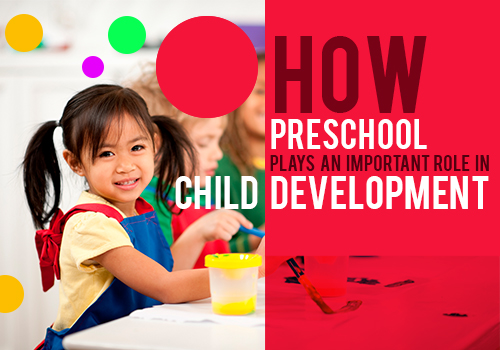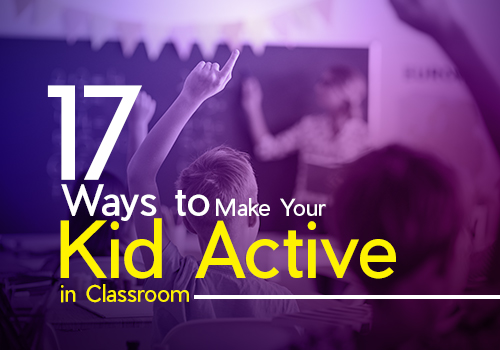Education that is imparted during early childhood goes a long way in shaping the kid into a promising individual. This happens when kids step into a preschool. Alongside helping kids to socialize with their peers, preschools come as perfect instruments that can boost their confidence levels. As the name suggests, a preschool can be a stepping stone for kids to eventually love and appreciate the format behind normal schooling. Here we describe how preschool plays an important role in child development.
- The First “Home Away From Home”
It will not be an overstatement to quote that preschool education is a small step for a giant leap. Stepping out of the comfort zones created by known territories along with the constant supervision of parents, preschoolers experience the first feel of a “Home Away from Home” through a preschool.
Preschools come with lots of material supported by the cordial supervision of teachers to make the transition from home to preschool secure and comfortable. Slowly yet steadily, a preschool becomes the second home of kids where they not only familiarize themselves with the new surroundings but also socialize with teachers and their classmates. Adaptability is the lesson that is imparted by preschools to kids at a very tender age.
- A Place That Builds Self-Esteem In Kids
Self-esteem is a combination of two traits; namely: self-confidence and self-respect. Preschools teach kids the importance of self-esteem when kids begin to recognize the importance of their name; for the very first time. A preschool will not only introduce your kids to identify various objects, it will also be the first place for budding friendships between preschoolers.
You will begin to see your kid transform into a confident student when he/she will begin to express feelings of happiness, anger, fear and disinterest without any reservations. Not only will your kid get to know about his/her classmates but will also know about his own self, through his preschool education.
- Education During Formative Years Has Its Own Benefits
Most of the preschools admit kids around the age of 2.5 years; an impressionable age that will carry the stories of childhood into adulthood. Until then, kids learn by observation, staying at home and aping the acts of parents and guardians. Preschools come in as effective learning platforms for kids who can apply the skills and knowledge gained here for the rest of their lives.
This move of introducing kids to early education not only improves their social skills but also paves the way for fewer behavioral problems. It is only through preschools that kids learn about healthy competition along with coming up with good grades without any special attention.
- Fun Learning – A Keyword to Preschool Education
What makes preschools the most attractive option for kids? It is through preschools that kids enjoy a perfect blend of fun and learning. When kids are taught in a playful manner, they not only learn better but will also hone their creative skills in coming up with alternatives that most of the times surprise the elders too.
It is through this fun-filled learning that preschoolers will emerge as individuals with a strong personality that was shaped during his/her formative years. All in an attempt to bring up kids with a keen sense of individuality, preschools are the educational places where parents and teachers can make the most of the impressionable and curious minds of kids.
- There Is Never A Dull Moment In a Preschool
Toying with different objects, playing in the sand pit or learning rhymes through actions are all the creative ways in which kids will engage themselves in their preschool days. Preschools come up with activity days when kids can pick up anything like coloring with crayons, building blocks or clay modeling that interests them.
Alongside these activities, kids will thoroughly enjoy the constant interactions between other kids, setting the stage for a healthy and engaging form of constant learning. It is through these art and craft activities through which the kids will find education entertaining and refreshing as well.
- The Piece-Meal Approach Followed By Preschool Teachers
Preschool teachers are trained to introduce a variety of methods that can help kids register a mental growth alongside laying a strong foundation of the subject fundamentals. However, these well-trained teachers ensure that they introduce kids to new things in small portions. This method does not burden the kid, allowing him the luxury to learn at his own pace.
It is through such stress-free learning environments that kids will also begin to scribble on paper their first versions of alphabets and numbers, one at a time. Following the principle of “don’t bite more than you can chew”, the piece-meal learning approach of preschools helps kids to assimilate information at a pace that every kid is comfortable with.
- Lessons About Same and Different
It is in a preschool that your kid begins to not only appreciate the presence of kids with similarities and other who are different; may be with size or color. It is not only about identifying the differences but also tolerating them so that they will turn out to be respectful and compassionate citizens that the world will look up to.
It is through preschool education that kids will fall into social groups that attract them the most. It is through this socializing that children will be able to build healthy friendships. Bestowing a positive influence on kids, preschools through trained teachers become a platform to discover their bodies and emotions which can be different from their peers.
- Self-Awareness – A Lifelong Lesson Taught In Childhood
Preschools teach kids to identify and safeguard their prized possessions; like their school bag, tiffin box, water bottle and napkin. This is a lesson connected to self-awareness that is imparted by preschools. Most of the times, preschoolers leave their toys and belongings in a mess.
A preschool teacher who finds things of kids left helter-skelter can teach them an invaluable lesson of responsibility. Making the preschooler responsible for his belongings, it is in a preschool environment that you can bring in elements of fun and interaction to the regime of orderliness.
- The Importance of Time Management
Preschools which follow a daily routine of assembly time, play time, study time and recess teach the importance of time management; the fun-filled way. They begin to understand that there is a time for everything and that they need to keep up the time so as to fall in line with the decorum of the preschool.
Preschools teach punctuality in kids when they will be taught to reach on time along with sticking to timeframes concerning eating, playing and sleeping. Certain preschools come up with colorful calendars that enlist simple activities in relation to the time taken by kids to complete them. It can be a simple task as coloring an image. Putting up this calendar encourages preschoolers to appreciate the value of time.
- A Thriving Platform for Extra-Curricular Activities
It is through a preschool that parents and educators get to know the innate talents in kids. When kids engage themselves in activities like singing songs, narrating stories or reciting rhymes, they begin to enjoy the company of their peers alongside honing their oratory skills. Literary celebrations in preschools can help showcase the acting talent in some kids who will perform their acts without stage fright.
Preschools are the bustling places for physical activities. When kids are taught to be physically active at an early age, they carry this regime for the rest of their lives, picking up a sport they love the most. Play and extra-curricular activities in preschools are thus critical instruments to promote holistic development in kids.
KeyTakeaways
The key to success lies with childhood education which is imparted by preschools. Along with the well-chalked out curriculum of preschools, well-trained teachers lay the foundation for a healthy learning and growing environment for kids. Once kids step into preschools, they not only learn to communicate with peers but also with teachers which improves their linguistic aptitude coupled with the power of expression. Thus, every kid who walks out of his/her preschool will be armed to take on kindergarten education as the next step to learning and development.


